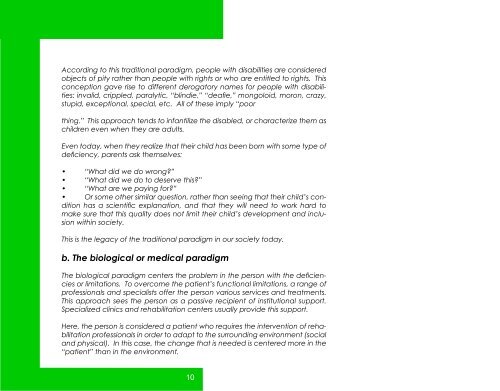in English - Handicap International
in English - Handicap International
in English - Handicap International
Create successful ePaper yourself
Turn your PDF publications into a flip-book with our unique Google optimized e-Paper software.
Accord<strong>in</strong>g to this traditional paradigm, people with disabilities are considered<br />
objects of pity rather than people with rights or who are entitled to rights. This<br />
conception gave rise to different derogatory names for people with disabilities:<br />
<strong>in</strong>valid, crippled, paralytic, “bl<strong>in</strong>die,” “deafie,” mongoloid, moron, crazy,<br />
stupid, exceptional, special, etc. All of these imply “poor<br />
th<strong>in</strong>g.” This approach tends to <strong>in</strong>fantilize the disabled, or characterize them as<br />
children even when they are adults.<br />
Even today, when they realize that their child has been born with some type of<br />
deficiency, parents ask themselves:<br />
• “What did we do wrong?”<br />
• “What did we do to deserve this?”<br />
• “What are we pay<strong>in</strong>g for?”<br />
• Or some other similar question, rather than see<strong>in</strong>g that their child’s condition<br />
has a scientific explanation, and that they will need to work hard to<br />
make sure that this quality does not limit their child’s development and <strong>in</strong>clusion<br />
with<strong>in</strong> society.<br />
This is the legacy of the traditional paradigm <strong>in</strong> our society today.<br />
b. The biological or medical paradigm<br />
The biological paradigm centers the problem <strong>in</strong> the person with the deficiencies<br />
or limitations. To overcome the patient’s functional limitations, a range of<br />
professionals and specialists offer the person various services and treatments.<br />
This approach sees the person as a passive recipient of <strong>in</strong>stitutional support.<br />
Specialized cl<strong>in</strong>ics and rehabilitation centers usually provide this support.<br />
Here, the person is considered a patient who requires the <strong>in</strong>tervention of rehabilitation<br />
professionals <strong>in</strong> order to adapt to the surround<strong>in</strong>g environment (social<br />
and physical). In this case, the change that is needed is centered more <strong>in</strong> the<br />
“patient” than <strong>in</strong> the environment.<br />
10

















